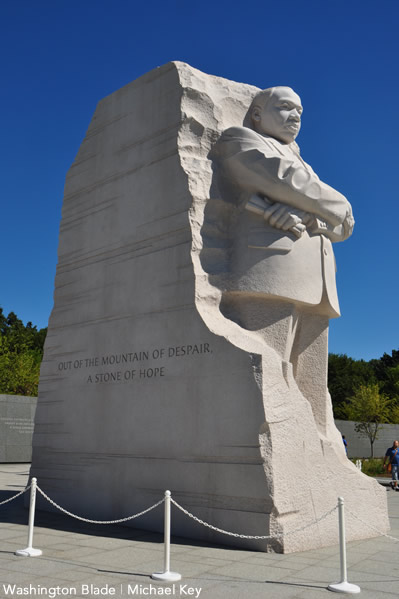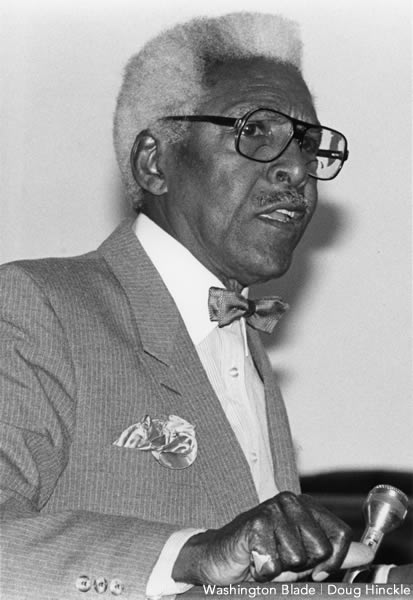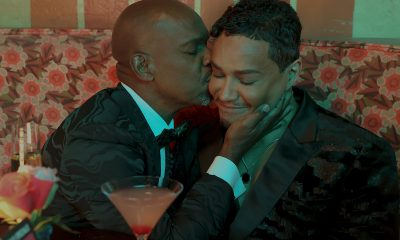Living
A dream fulfilled
MLK memorial, years in the making, resonates with LGBT community


The civil rights movement pioneered by Martin Luther King, Jr., has inspired many leaders of the LGBT movement. (Washington Blade photo by Michael Key)
(UPDATE: The MLK Memorial dedication ceremony has been postponed due to Hurricane Irene. It is expected to be rescheduled for September or October.)
When a tribute to the Rev. Martin Luther King, Jr. is dedicated this weekend, it will mark more than the addition of a new monument to Washington, D.C.’s landscape.
It will symbolize the civil rights leader’s success.
The stone likeness rises as the first monument to a man of color on the National Mall, 48 years after King described his then ground-breaking dream, and in a nation where — at least ostensibly — much of that dream has been realized.
The movement was a model for countless others, including the LGBT rights push, which has shared nonviolence tenets and even leaders like gay, black activist Bayard Rustin.
Yet most similarities end there.
While fruits of the civil rights movement are evident in modern America — apparent in a widening black middle class and a black first family in the White House, for instance — the gay rights movement’s successes have been slower coming.
Same-sex marriage rights remain tenuous and limited to a handful of states; despite hate crime legislation, the threat of violence continues to deny many gays and lesbians a basic sense of safety in their hometowns.
As the nation prepares to welcome King to the National Mall, community leaders share their outlook on the LGBT movement with the Washington Blade — from a California group using civil unrest to humanize the struggle; to the partner of late gay and civil rights icon Bayard Rustin working to keep his ideals alive; to former NAACP leader Julian Bond, who uses his status as a key historic civil rights figure to promote the LGBT rights struggle as a modern civil rights fight.
They point to entrenched faith-based bigotry, and even a lack of movement cohesion, as obstacles. But each believes that by using King’s model of continued struggle, the LGBT dream of full equality can be achieved.
Images of change
The Rev. Martin Luther King, Jr. sitting in an Alabama jail cell. Firefighters battering blacks with powerful jets of water. Jeering whites pouring condiments over the heads of stoic lunch counter protesters.
They’re images that moved activist Robin McGehee, as a child growing up in Jackson, Miss.
And today as executive director of GetEqual, she organizes demonstrations to create actions and images she hopes will drive home the plight of gay and lesbian men and women just as powerfully. An absence of such visual tools encouraged McGehee to form the group, with offices in Berkeley, Calif., and Washington, D.C., in January 2010.
“We had that in reference to the AIDS movement in ACT-UP, and fighting for adequate health care. But in reference to a full civil rights fight for equality, I couldn’t think of one iconic action,” she said.
The group has orchestrated more than 40 actions in the last year, including one in which military veterans handcuffed themselves to the White House fence to protest “Don’t Ask, Don’t Tell.”
The group honed use of such actions at the Highlander Research and Education Center, a New Market, Tenn., center that trained members of the original civil rights movement. McGehee and other LGBT equality activists underwent training at the historic center in January 2010.
“Not until you can give literal imagery to that discrimination do people really resonate or get it,” McGehee said.
Yet despite mirroring the earlier movement’s successful tactics, activists’ success in mainstreaming LGBT rights remains light years behind that of racial equality — something McGehee blames on entrenched religious bigotry.
“We’ve gotten into a moment where people are using the Bible as a weapon,” said McGehee, pointing out that while religious rhetoric once justified slavery and racism, cultural changes eventually erased such thinking. “… I don’t think we’ve jumped that hurdle with regard to gays.”
McGehee is encouraged, however, by more subtle success in incorporating gays and lesbians socially. Just a few years after Ellen DeGeneres thought twice about coming out on TV, realistic portrayals of gays and lesbians are common on TV.
“In time,” she said, “I think we’re gonna get there.”
A life of service

The former partner of Bayard Rustin said the gay civil rights leader would be happy with the arrival of marriage equality, but would have pushed for it in all 50 states. (Washington Blade archive photo by Doug Hinckle)
Walter Naegle had certainly heard of Bayard Rustin, the relentlessly active civil rights agitator who gained as much notoriety for his efforts to win black equality as for his open homosexuality.
But on the day he ran into the civil rights legend on a New York City corner in April 1977, he didn’t recognize him: Rustin wasn’t carrying his trademark walking stick.
“When he gave me his name, I knew,” said Naegle, whose chance meeting with Rustin lead to a 10-year relationship that ended only when the activist died in 1987.
More than two decades later, Naegle keeps Rustin’s ideals alive, working with filmmakers to promote “Brother Outsider,” a portrayal of Rustin’s story, executing his estate and generally overseeing the use of his image.
He believes Rustin’s courage, openness and tireless work — he was in his 70s and still agitating when he died — have helped make him resonate as an icon of the human rights movement.
By the time Naegle met Rustin, the activist had long been a legend. Rustin had worked with A. Philip Randolph to strengthen relationships between blacks and labor unions, but was perhaps best known for his role organizing the 1963 March on Washington.
He’d also become a gay rights icon before it was fashionable: Rustin was essentially outed in 1953 when he was arrested on a “morals charge,” yet he refused to deny the charges or his sexual orientation.
“He didn’t have to hide anything,” he said. “He was just going to be who he was and let the chips fall where they may.”
Rustin would pay the price for that openness.
“Whenever he would rise to a certain level, particularly in the African-American civil rights movement but also in other movements, something would happen and someone would try to chop him down,” Naegle said.
Nonetheless, “He was not defeated. He didn’t turn around and stop his activism — he just worked on the sidelines.”
Rustin remained active with several organizations, including the A. Philip Randolph Institute and the United States Holocaust Memorial Council, at the time of his death.
Years later, his story still has the power to inspire. Naegle said a book of his letters is slated for publication in March, in time for what would have been Rustin’s 100th birthday.
Naegle believes his partner would have been “heartened” to see marriage equality happen in even one state. But he wouldn’t have been satisfied with limited success.
“It’s fine to have these victories in urban areas,” Naegle said. “But people all over the country should be entitled to the same thing.”
“Gay and lesbian rights are not ‘special’ rights”
Julian Bond’s new fight

Former NAACP Chair Julian Bond likens the modern LGBT movement to the push for black civil rights in the ‘60s. (photo courtesy of wikimedia.org)
Where others may see conflict between the black and gay rights agendas, Julian Bond sees similarities.
Both groups struggle against bigotry based on personal characteristics. Both are entitled to basic rights by the same Constitution. And both benefit from each others’ successes.
Indeed, he argues, “People of color ought to be flattered that our movement has provided so much inspiration for others — that it has been so widely imitated,” Bond, who works as an adjunct professor at American University, told the Blade.
The man who has worn many hats as a Georgia lawmaker and leader with both the Southern Poverty Law Center and the NAACP, has more recently directed his outspoken energies to the conflict between civil rights and gay rights advocates.
It’s a particularly touchy dispute. Old school civil rights leaders and even some black gays bristle at LGBT activists’ use of King’s rhetoric to promote their agenda as a modern civil rights movement. Some site racial divisions within the LGBT movement, and argue that discrimination faced by gays isn’t as harsh as that faced by blacks.
Yet for Bond, there isn’t much of a dispute: The two groups must lock arms.
“Many gays and lesbians worked side by side with me in the ’60s civil rights movement. Am I now to tell them thanks for risking life and limb helping me win my rights, but they are excluded because of a condition of their birth?” he said. “That they cannot share now in the victories they helped to win?”
Bond has lent his outspoken rhetoric and organizational skills to many causes over the years.
While a student at Morehouse College, in Atlanta, in the ’60s, he helped organize the Student Nonviolent Coordinating Committee, he was the first president of the SPLC and was board chairman of the National Association for the Advancement of Colored People from 1998 to 2010.
He’s become one of the most vocal mainstream voices in the movement to promote equal treatment for gays and lesbians, going as far as to boycott the funeral of King widow Coretta Scott King in 2006 after the services were arranged at an anti-gay church.
In July, Bond spoke at an NAACP forum discussing gay and lesbian issues in the black community, featuring openly gay black comedian Wanda Sykes and CNN anchor Don Lemon.
“People of color carry the badge of who we are on our faces. But we are far from the only people suffering discrimination,” Bond said. “Sadly so do many others. They deserve the law’s protections and civil rights too.”
Bond’s comments stand in contrast to the black community’s historically conservative stance on gay issues.
Yet he said one need only look at the personal examples set by the lauded civil rights leaders to see whether such thinking is in line with King’s dream.
“We cannot know what Dr. King would have thought about today’s GLBT movements,” Bond said. “But if we consider the prominent role his widow, Coretta Scott King, occupied in speaking out on GLBT rights, it is hard to believe that he would not have done the same.”
Real Estate
Celebrate the power of homeownership this Fourth of July
Owning a home is powerful act of self-determination

This Fourth of July, celebrate more than independence: celebrate the power of LGBTQ+ homeownership. Explore resources, rights, and representation with GayRealEstate.com, the trusted leader in LGBTQ+ real estate for over 30 years.
Home is more than a house: it’s a symbol of freedom
As the fireworks light up the sky this Fourth of July, LGBTQ+ individuals and families across the country are not just celebrating the nation’s independence — they’re celebrating personal milestones of freedom, visibility, and the right to call a place their own.
For many in the LGBTQ+ community, owning a home represents more than stability — it’s a powerful act of self-determination. After generations of discrimination and exclusion from housing opportunities, more LGBTQ+ people are stepping into homeownership with pride and purpose.
Why homeownership matters to the LGBTQ+ community
While progress has been made, LGBTQ+ homebuyers still face unique challenges, including:
- Housing discrimination, even in states with legal protections
- Limited access to LGBTQ+ friendly realtors and resources
- Concerns about safety and acceptance in new neighborhoods
- Lack of representation in the real estate industry
That’s why the Fourth of July is a perfect time to reflect not just on freedom as a concept, but on how that freedom is expressed in the real world — through ownership, safety, and pride in where and how we live.
Finding LGBTQ+ Friendly Neighborhoods
One of the top concerns for LGBTQ+ buyers is whether they’ll feel safe, accepted, and welcome in their new neighborhood. Thanks to evolving attitudes and stronger community support, many cities across the U.S. now offer inclusive, affirming environments.
Some of the best cities for LGBTQ+ home buyers include:
- Wilton Manors, Fla. – A vibrant LGBTQ+ hub with strong community ties
- Palm Springs, Calif. – A longtime favorite for LGBTQ+ homeowners
- Asheville, N.C. – Progressive and artsy, with growing LGBTQ+ visibility
- Portland, Ore. – Inclusive, eco-conscious, and diverse
- Philadelphia, PA – Rich in history and LGBTQ+ community leadership
When you work with an LGBTQ+ friendly realtor, you get insight into more than property values — you get a real perspective on where you’ll feel most at home.
Navigating the real estate process with confidence
Whether you’re a first-time gay homebuyer or preparing to sell your home as an LGBTQ+ couple, it’s essential to understand your rights and options. Here are a few key tips:
1. Work with a trusted LGBTQ+ real estate agent
Representation matters. A gay realtor, lesbian real estate agent, or LGBTQ+ friendly agent understands the unique concerns you may face and advocates for you every step of the way.
Use GayRealEstate.com to connect with LGBTQ+ real estate agents near you. For over 30 years, we’ve helped LGBTQ+ buyers and sellers find their ideal home and a professional who respects their identity.
2. Know your legal protections
While federal law (via the Fair Housing Act and Supreme Court rulings) prohibits housing discrimination based on sexual orientation or gender identity, enforcement can vary by state. Make sure to research:
- State-level housing discrimination laws
- Local LGBTQ+ protections and resources
- What to do if you experience discrimination during a transaction
3. Secure inclusive financing
While most lenders follow fair lending rules, it’s smart to seek out banks or credit unions with LGBTQ+ inclusive policies and a history of non-discriminatory lending practices.
4. Plan for the future as a family
For same-sex couples, especially unmarried partners, it’s vital to review how you’ll hold the title, designate beneficiaries, and plan your estate.
Ask your agent or attorney about:
- Joint tenancy with right of survivorship
- Living trusts
- Powers of attorney and healthcare proxies
Selling a home as an LGBTQ+ homeowner
If you’re listing your home, working with a gay-friendly real estate agent ensures your identity and story are honored — not hidden — in the process.
Highlight:
- Your community connections
- Your home’s role in creating a safe space
- Local LGBTQ+ resources to attract like-minded buyers
Showcasing the full value of your home includes sharing what it meant to live there authentically and safely.
Your home, your freedom
The Fourth of July reminds us that freedom isn’t just an abstract idea — it’s lived every day in the spaces where we find comfort, love, and belonging. For the LGBTQ+ community, the right to own and thrive in a home is part of the larger journey toward full equality.
At GayRealEstate.com, we believe every LGBTQ+ person deserves:
- A safe place to live
- A community that welcomes them
- An advocate in the home buying or selling process
Ready to make a move?
Whether you’re dreaming of your first home, upgrading with your partner, or selling a space that helped shape your identity, GayRealEstate.com is your trusted partner. With our nationwide network of gay realtors, lesbian real estate agents, and LGBTQ+ friendly professionals, we make your journey smooth, respectful, and informed.
Visit GayRealEstate.com to:
- Search LGBTQ+ friendly homes
- Connect with inclusive real estate agents
- Access free guides for buyers and sellers
- Protect your rights and get expert advice
This Fourth of July, celebrate more than independence — celebrate your freedom to live, love, and own with pride.

Did you melt like the Wicked Witch of the West this week?
As summer temperatures rise, keeping your home or apartment cool during a heat wave can become both a comfort issue and a financial challenge. One of the most effective ways to keep a home cool is to prevent heat from entering in the first place. Sunlight streaming through windows can significantly raise indoor temperatures. Consider the following solutions:
• Close blinds or curtains during the hottest parts of the day. Blackout curtains or thermal drapes can reduce heat gain by up to 30%.
• Install reflective window films to block UV rays and reduce solar heat without sacrificing natural light.
• Use outdoor shading solutions such as awnings (yes, the ones you removed because they were “dated”) and shutters to limit direct sunlight.
Fans are a cost-effective way to circulate air and create a wind-chill effect that makes rooms feel cooler.
• Ceiling fans should rotate counterclockwise in the summer to push cool air down.
• Box fans or oscillating fans can be placed near windows to pull in cooler evening air or push hot air out.
• Create a cross-breeze by opening windows on opposite sides of your home and positioning fans to direct airflow through the space.
• For an extra cooling effect, place a bowl of ice or a frozen water bottle in front of a fan to circulate chilled air.
To optimize natural ventilation, open windows early in the morning or late in the evening when outdoor temperatures drop. This allows cooler air to flow in and helps ventilate heat that built up during the day.
Appliances and electronics generate a surprising amount of heat. To reduce indoor temperatures:
• Avoid using the oven or stove during the day; opt for no-cook meals, microwave cooking, or grilling outside.
• Run heat-producing appliances like dishwashers and clothes dryers in the early morning or late evening.
• Unplug electronics when not in use, as even standby power can add heat to your space.
• Switching to energy-efficient LED lightbulbs can also reduce ambient heat compared to incandescent lighting.
If you do use an air conditioner, maximize its effectiveness by:
• Setting it to a reasonable temperature—around 76–78°F when you’re home and higher when you’re away.
• Cleaning or replacing filters regularly to maintain airflow and efficiency.
• Sealing gaps around doors and windows to prevent cool air from escaping. (Didn’t we all have a parent who said, “Close the door. You’re letting all the cool out?”)
• Using a programmable thermostat to optimize cooling schedules and reduce energy use.
If it is not cost-prohibitive, adding insulation in attics and walls can greatly reduce heat transfer. Solar panels that reflect heat can also help, as well as offset the cost of their installation. Adding weatherstripping around doors and windows, sealing cracks, and using door sweeps can make a significant difference in keeping heat out and cool air in.
Natural and eco-conscious methods can also help cool your home.
• Snake plants, ferns, or rubber trees can improve air quality and slightly cool the air through transpiration.
• White or reflective roof paint can reduce roof temperatures significantly.
• Cooling mats or bedding can make sleeping more comfortable without cranking up the A/C.
For renters or those who can’t make permanent modifications, there are still plenty of ways to keep cool.
• Use portable fans and A/C units instead of built-in systems, making sure they are the correct size for your space.
• Removable window film or static cling tinting can reflect heat without violating your lease.
• Install tension rod curtains or temporary blackout panels instead of hardware-mounted window coverings.
• Add draft blockers and weatherstripping tape that can be applied and removed without damage.
• Cover floors with light-colored rugs to reflect heat rather than absorb it.
• If allowed, use temporary adhesive hooks to hang reflective materials or light-filtering fabrics over windows.
Even if your space is warm, you can still take steps to help your body stay cool.
• Wear light, breathable fabrics like cotton or linen.
• Stay hydrated and avoid caffeine or alcohol during peak heat hours.
• Take cool showers or use damp cloths on your neck and wrists to bring your body temperature down.
Keeping your home or apartment cool in the summer doesn’t have to be expensive or energy-intensive. With a few adjustments such as blocking sunlight, optimizing airflow, using fans effectively, and making renter-friendly upgrades, you can create a more comfortable indoor environment while keeping energy bills in check.
Valerie M. Blake is a licensed Associate Broker in D.C., Maryland, and Virginia with RLAH @properties. Call or text her at 202-246-8602, email her at DCHomeQuest.com, or follow her on Facebook at TheRealst8ofAffairs.
Real Estate
The world’s on fire and D.C. is on sale (sort of)
Prices are up, but then again, nothing makes sense anymore

ICE is disappearing people, revered government agencies are shuttering, and who knows if we’ll be in World War III next week? But can you believe prices in D.C. are actually still up 6.3% since last year? It doesn’t make sense, and perhaps that does make sense, because nothing seems to make any sense any more.
That said, there are some parts of our market that are truly suffering. The interest rates, which have been up, up, up for about four years now, are the ongoing rain on our market’s military parade. Combine that with 75,000 federal employees taking a buyout nationwide, and DOGE cuts eliminating around 40,000 federal jobs in the District (per estimates by the D.C. CFO), not to mention thousands of other job losses in non-governmental organizations due to funding and program cuts, and you’ve got a case of uncertainty, and downright unaffordability in the pool of otherwise would-be buyers.
This has had a marked impact on properties that starter-home buyers and low- to mid-level employees would otherwise buy, most notably condominium and cooperative apartment units. These properties have already slowed in our market thanks to the profound impact that higher interest rates have had on their monthly carrying costs—pair that with job insecurity, and a lot of condos are proving to be very difficult to sell indeed.
So how is the average sale price up in our market?
The increase is almost entirely due to the resounding strength of the single-family home market, especially in upper Northwest D.C., where it is still quite common to see bidding wars, even on properties pushing past the $3M mark. It seems that buyers in that echelon are less impacted by a few percentage points in the interest rate, and less concerned about their job security. Notably, those buyers are often married with children and have an absolute need for more space, must stay in the area due to one spouse’s job, or the kid’s friend group, regardless of whether the cost of owning is thousands of dollars more per month than it would have been in 2020 or 2021. The continued appreciation in these neighborhoods defies imagination.
So, what to do if you are not one of those lucky enough to be shopping for a $3M home? The short answer: wait. If you want more space, rent your current place out and learn the joys of being a landlord while someone else pays your mortgage. Need the equity from your current home to buy your next place? Get a home equity line of credit, or loan, and pull the equity out of your current place to buy the next one. Or—and I have never recommended this before in 21 years of being a Realtor—rent for a few years. Sure, I’d love to list and sell your condo so you can climb the real estate ladder, but it might just be a waste of time, money or both if you could just ride out this storm and sell in a DOGE-less future.
All this said, there are some condos that seem to be immune from this recent negative news. Anecdotally, it feels like it’s the truly special ones that do just fine no matter the market. Our recent listing in Capitol Hill had a view from every one of its 15 windows of the Supreme Court. Sold in five days with six offers. Another condo was on the top two floors of a townhouse and had the coolest black wood floors that gleamed like a grand piano. Sold in four days at full price.
So, all is not for naught if you have a condo or home in an area that people want to be in, with nice space, light, amenities and a certain je ne sais quois. And, as long as we have a democracy in a few years, my experience says our market will be back, stronger than ever, really soon.
David Bediz is a Realtor and mortgage loan broker for the Bediz Group LLC and Home Starts Here, LLC. Reach him at [email protected].




















